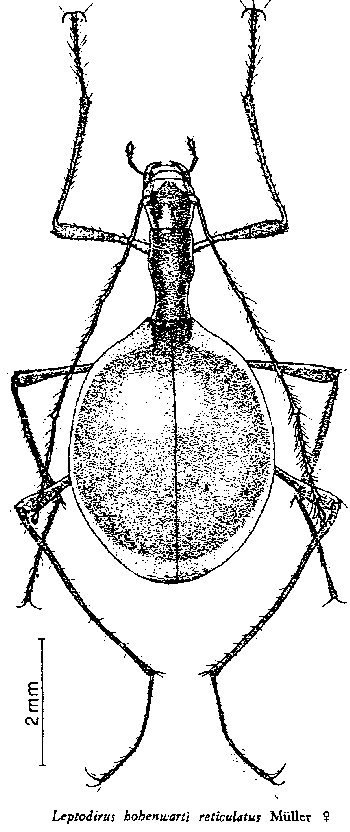|
Biospeleology of the Piemonte |
 |
Systematic Photographic |
|
Biospeleology of the Piemonte |
 |
Systematic Photographic |
 |
|
|
|
 |
 |
 |
 |
 |
 |
|
|
|
|
|

An outline of Biospeleology

A little of history
The life in the dark isn't right for the humans, accustomed as we are to estimate by means of the sight the distances and to adjust our movements to the environment that we perceive around us. The situation of an individual that fall suddenly in the dark, in a disowned environment, generates apprehension and disorientation. For this in the course of the history around to the natural cavities rosefs a lot of legends about fantastic monsters, dragons and ghosts.
We do not have to forget, but, that the prehistoric man has found in the caves a place surer than the external environment in which to take refuge against the inclemencies of the weather, the predator animals and, often, agaist the enemy tribes of other humans.
These primitives, explorers for necessity, were forced to dispute the possession of the cavities in which to stay against animals that already had settled down and this has been testified us by archeological finds constituted by contemporaneous prints of human and animal feet and by teeth, objects, paintings, recordings that after millenia have reached ours days and tell us how much were hard the existence of these our ancestors.
An prehistoric find datable approximately to 30,000 years ago, found in France in Ariège, Pyrenees, in the "Grotte des Trois-Frères", is an image on a bone of bison, that represents a cave-dwelling insect; it is a drawing so faithfully that we can identified the insect as a species of the genus Troglophilus, a grasshopper similar to Dolichopoda ligustica. Probably this our remote ancestor artist could observe this insect normally in the cave that constituted his room and that wasn't for him a reason of scientific interest, but, probably, one entomological varying to his diet, like a lot of other bugs. Even if improperly, we could consider this troglodyte as the first biospeleologist.
We must arrive in 1689 for having the first written news regarding a troglobitic entity; in that year, in fact, the baron Johann Weichard Valvasor described the finding of an animal called "Dragon" by the popular fantasy and that periodically, with the floods, was carried outside from its hypogean environment by the impetuousness of waters.
In 1768 Laurenti in a work entitled "Il Dragone" ("The Dragon"), described this same blind amphibian and attributed it the scientific name with which still today it is known: "Proteus anguinus".
In 1799, the german explorer Alexander von Humbolt, during one of his travels in the South America, visited a great cave that was called "Cueva del Guacharo", and described a bird of remarkable dimensions, called by the aborigines "Guacharo" (Steatornis caripensis); this bird nests in the Venezuelan caves and today it's in danger of extinction and object of protection because of the credences of the local people that thought its nests endowed of aphrodisiac powers.
The first true scientific studies having as object the "Proteus", dated 1829, were carried out by Configlianchi and Rusconi.
We can but date the birth of the modern Biospeleology in 1831 with the discovery, by an Austrian naturalist, the count Franz von Hohenwart, of the first cavernicolous insect: Leptodirus hohenwarti, a Coleoptera Cholevidae deeply adapted to the hypogean life.

In 1842 De Kay discovered in Kentucky a blind cavernicolous fish (Amblyopsis spelaea) and in 1849 with the
first monography on the insects living in the cave
of Adelsberg by the Danish J.C. Schiödte we can affirm that the first biospeleological search are
begun.
The term "BIOSPELEOLOGY" has been coined by Virè in 1904: the positivist burst that characterized the end of the IX° century carried to active search on the field with the discovery and the description of a lot of new species more or less adapted to the hypogean environment. Often animals that came accidentally in cave, were considered cavernicolous, with errors of ecological and biological interpretation.
Racovitza, Rumanian naturalist, is considered the father of the modern biospeleology and in 1907 he published hiss ideas giving a corrected formulation to the studies that would have been developed in the first half of the XX° century. Rose the first underground laboratories and the first one was prepared from the Virè, but a flood of the Seine destroyed it in 1910.
Since the beginning of the century numerous studious have been taken care of biospeleology and in particular Packard, Absolon, Jeannel, Leruth, Chappuis and more recently in the Piemontese region, Allegretti, Boldori, Bologna, Casale, Cavazzuti, Focarile, Ghidini, Giachino, Vailati, Vigna Taglianti, Stoch and many others.
Today, the term Biospeleology has a larger meaning; in the fifties, some searchers, among which the Italians Bucciarelli, Meggiolaro, Tamanini, Agazzi and others, increased with good intuition their biospeleological studies to those places that have environmental characteristics similar to the caves, like temperature and humidity.
The studies, lead in underground superficial environment and endogean, carried gradually, with better techniques, to ascertain that a lot of species, thought exclusively hypogean, lives also in those portions of the ground that introduces environmental characteristics comparable to those of the caves (hypogean environment).
The "Biospeleology" or "Biospeology" (in the opinion of other authors) studies the several biocenoses of the underground environments and in particular of the karstic environment, hypogean and endogean, and its limitrofe zones; by extension we can also to ascribed in this study those species who show adaptations to the subterranean life, like certain crustaceans and other invertebrates that live under sands in coastal marine environment. The Biospeleology is not only the search in the caves of species adapted to this environment, sometimes new for the Science, but also all those information of ecological, biological and ethological character and about the physiology and the geographic distribution of the species and on the interrelations among the same ones; naturally the systematich has an important part in this studies, with the techniques for the identification and taxonomical and evolutionary classification of the biological entities.
The biospeleological and biogeographical studies have allowed recently to clear aspects of the geologic history of the territories in which they have been carried out with particular care to the glaciations and their effects.

An outline of Biospeleology

 |
 |
 |
 |
 |
BIBLIOGRAPHY |
BIBLIOGRAPHY |
BIBLIOGRAPHY |



|
Biospeleo SUMMARY |
Systematic Index |
|




Some embellishments, Javascript, etc. have been modified
from them situated on the site 
"A SBAFO! All for the WEB gratis and in
Italian... "; the author advise you to visit it.




